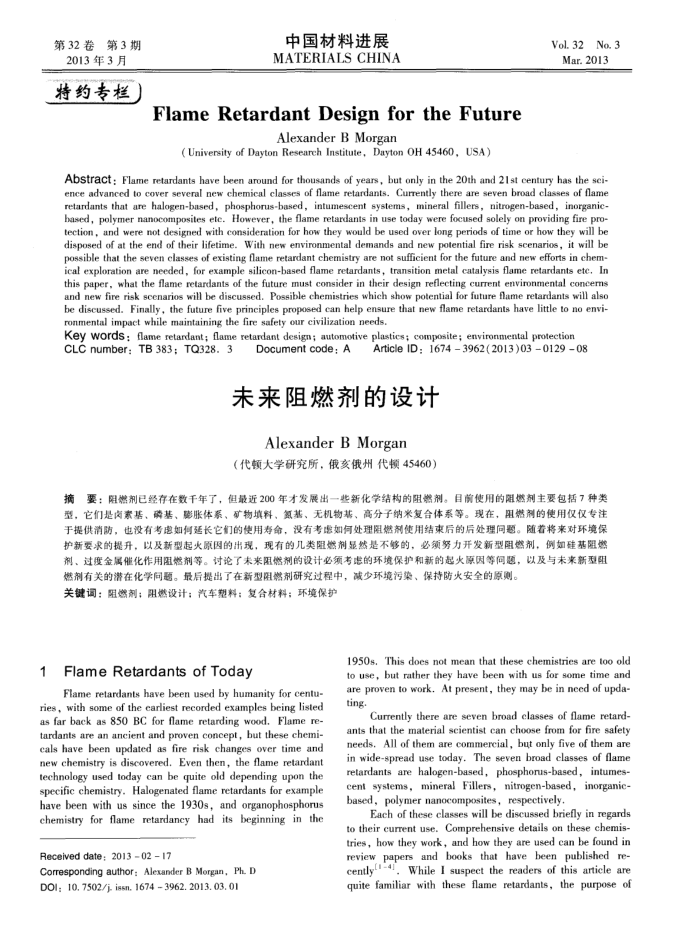内容简介
 第32卷
第32卷第3期
2013年3月特约专栏
中国材料进展 MATERIALS CHINA
Flame Retardant Design for the Future
Alexander B Morgan
( University of Dayton Research Institute, Dayton OH 45460, USA)
Vol.32
No.3
Mar.2013
Abstract: Flame retardants have been around for thousands of years, but only in the 2Oth and 21st century has the sci-ence advanced to cover several new chemical classes of flame retardants. Currently there are seven broad classes of flame retardants that are halogen-based, phosphorus-based, intumescent systems, mineral fillers, nitrogen-based, inorganic-based, polymer nanocomposites ete, However, the flame retardants in use today were focused solely on providing fire pro-tection, and were not designed with consideration for how they would be used over long periods of time or how they will be disposed of at the end of their lifetime. With new environmental demands and new potential fire risk scenarios, it will be possible that the seven classes of existing flame retardant chemistry are not sufficient for the future and new efforts in chem-ical exploration are needed, for example silicon-based flame retardants, transition metal catalysis flame retardants etc, In this paper, what the flame retardants of the future must consider in their design reflecting current environmental concems and new fire risk scenarios will be discussed. Possible chemistries which show potential for future flame retardants will also be discussed. Finally, the future five principles proposed can help ensure that new flame retardants have little to no envi-ronmental impact while maintaining the fire safety our civilization needs.
Key WwOrdS : flame retardant; flame retardant design; automotive plastics; composite; environmental protection
Article ID: 1674 3962(2013)03 0129 08
CLC number:TB383;TQ328.3
Document code: A
未来阻燃剂的设计
AlexanderBMorgan
(代顿大学研究所,俄亥俄州代顿45460)
摘
要:阻燃剂已经存在数千年了,但最近200年才发展出一些新化学结构的阻燃剂。目前使用的阻燃剂主要包括7种类
它们是肉素基、磷基、影胀体系、矿物填料、氮基、无机物基、高分子纳米复合体系等。现在,阻燃剂的使用仅仅专注型,
于提供消防,也没有考虑如何延长它们的使用寿命,没有考虑如何处理阻燃剂使用结束后的后处理间题。随着将来对环境保护新要求的提升,以及新型起火原因的出现,现有的几类阻燃剂显然是不够的,必须努力开发新型阻燃剂,例如硅基阻燃剂、过度金属催化作用阻燃剂等。讨论了未来阻偿剂的设计必须考虑的环境保护和新的起火原因等间题,以及与未来新型阻燃剂有关的潜在化学间题。最后提出了在新型阻燃剂研究过程中,
减少环境污集、保持防火安全的原则。
关键词:阻燃剂;阻燃设计:汽车塑料:复合材料;环境保护
FlameRetardants ofToday
Flame retardants have been used by humanity for centu-ries, with some of the earliest recorded examples being listed as far back as 850 BC for flame retarding wood. Flame re-tardants are an ancient and proven concept, but these chemi-cals have been updated as fire risk changes over time and new chemistry is discovered. Even then, the flame retardant technology used today can be quite old depending upon the specific chemistry. Halogenated flame retardants for example have been with us since the 1930s, and organophosphorus
hadits
beginning in the
chemistry for flame retardancy Received date; 2013 02 17
Corresponding author; Alexander B Morgan, Ph, D DOI; 10. 7502/j, issn, 1674 - 3962. 2013. 03. 01
1950s. This does not mean that these chemistries are too old to use, but rather they have been with us for some time and are proven to work, At present, they may be in need of upda-
ting.
Currently there are seven broad classes of flame retard-
ants that the material scientist can choose from for fire safety
All of them are commercial, but only five of them are
needs.
in wide-spread use today. The seven broad classes of flame retardants are halogen-based, phosphorus-based,
intumes-
cent systems, mineral Fillers, nitrogen-based, inorganic-based, polymer nanocomposites, respectively.
Each of these classes will be discussed briefly in regards to their current use. Comprehensive details on these chemis-tries, how they work, and how they are used can be found in review papers and books that have been published re-cently(--4],
While I suspect the readers of this article are
quite familiar with these flame retardants, the purpose of
上一章:橡胶纳米复合材料计算机模拟研究进展与挑战
下一章:循环型社会的生态环境材料